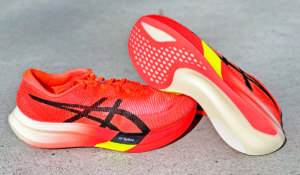New perk: Easily find new routes and hidden gems, upcoming running events, and more near you. Your weekly Local Running Newsletter has everything you need to lace up! Subscribe today.
Hidden in plain sight on the feet of several elite runners racing in the U.S. Olympic Trials Marathon earlier this month in Orlando, Florida, were pairs of brilliant red Asics shoes that were yet-to-be-announced updates to the brand’s Metaspeed marathon super shoes.
Four weeks later, now it can be told that Clayton Young, the runner-up in the men’s race and a newly minted member of the U.S. Olympic Team heading to the Paris Olympics this summer, was wearing a pair of Asics Metaspeed Sky Paris shoes. Not far behind him, Elkanah Kibet, the fourth-place finisher in the men’s race, was wearing a pair of Asics Metaspeed Edge Paris, as were Sarah Hall and Lindsay Flanagan, who were fifth and eighth in the women’s race, respectively.
This year’s crop of Asics’ high-performance carbon-fiber plated racing shoes will be available for purchase on March 4. After getting a confidential preview of the shoes the day before the Olympic Trials in Orlando, I received wear-test samples of each shoe in mid-February and have logged a variety of faster-paced runs and workouts in each of those shoes for the past two weeks.
At first glance, with the exception of almost imperceptibly different outsoles and midsole configurations, the shoes look virtually identical. Even their stack height and drop specs are the same this time around. Furthermore, both shoes feature new lasts (or interior shapes) for a better fit, a new PEBA-based FF Turbo+ midsole material, a new Motion Wrap 2.0 engineered knit upper, and new configurations of AsicsGrip outsole rubber segments.
But as with the predecessors to these models—the Metaspeed Sky+ and Metaspeed Edge+ that dropped two years ago— the two models are geared for decidedly different types of running gaits. Those differences are clear as soon as you’ve run a few fast miles in each model, and are especially evident in how each performs for a given runner.
The shoes were developed with considerable input from elite Asics athletes—including Young and Hall, as well as those in the brand’s Chojo Project training camps in Kenya and Font Romeu, France, says Paul Lang, the senior merchandising manager with the Asics’ performance running division. The development also included research, development and design work from the Japanese-based Asics Institute of Sports Science and input from the brand’s performance footwear division.
The project’s name comes from the Japanese term “Chojo,” which Asics founder Kihachiro Onitsuka was said to have used when launching new projects, Lang says.
“‘Chojo’ means ‘striving for the peak’ or going to the top of the mountain,” Lang says. “And that’s been the emphasis behind the Metaspeed shoes for the past four years.”
Racing shoes have come a long way since 2020, when almost every brand unveiled its first model of carbon–plated models and World Athletics created stack height and carbon-plated regulations for super shoes. Over the past four years, every brand has continued to reinvision its top-tier racing shoes to become lighter, livelier, more efficient and, in theory, faster. New, higher-performing foam materials and new plate configurations are constantly being developed and, with the understanding of new performance data, racing shoes are continuing to evolve.
“It’s a never-ending process,” Lang says. “The crazy thing is that as one model is on our athletes’ feet in races, that shoe is being rebuilt concurrently in parallel. As they are racing in the world championships, we’re already testing a new version with a new forefoot insert or foam. In three years, where we’ve come has been an exponential improvement.”
Here’s a breakdown of each of the new shoes and what to expect.

Asics Metaspeed Sky Paris
- Price: $250
- Weights: 5.2 oz. (women’s size 8), 6.4 oz. (men’s size 9)
- Stack Heights: 39.5mm (heel), 34.5mm (forefoot)
- Heel-Toe Offset: 5mm
In the Metaspeed Sky Paris, which is designed for runners with a long-striding gait, the carbon plate is situated higher in the shoe’s midsole, creating energy return that propels a runner in a slightly more vertical direction to extend stride length. The beveled shape of the rocker and upward curve of the toes—aka the toe spring—creates a smooth rolling sensation as your foot transitions to the toe-off phase at the end of a stride.
The geometry of the Asics Metaspeed Sky Paris continues to have a 5mm heel-toe offset but has been tweaked slightly with an additional 0.5mm thickness from heel to toe, going from a 39mm/34mm stack heights in the previous version to 39.5mm/34.5mm dimensions in this year’s edition.

Asics Metaspeed Edge Paris
- Price: $250
- Weights: 5.3 oz. (women’s size 8),6.5 oz. (men’s size 9)
- Stack Heights: 39.5mm (heel), 34.5mm (forefoot)
- Heel-Toe Offset: 5mm
In the Metaspeed Edge Paris, which is geared for high-cadence runners, the carbon-fiber plate is more curvy and situated lower within the shoe’s midsole (even more dramatically than the previous version), creating a softer feel and forward propulsion tuned to quicker stride turnover. Running in the Metaspeed Edge Paris, you’ll feel a more snappy sensation under your forefoot as each stride transitions quickly to toe-off via the more aggressive rocker shape that begins under the metatarsal heads. The geometry of the Metaspeed Edge Paris has changed from an 8mm offset (previously 39mm/31mm) to a 5mm offset (39.5mm/34.5mm)
RELATED: The Three Different Shoes Every Runner Needs
First Impressions
The first thing I noticed with each of the new models is slightly more secure and accommodating fit. The new Motion Wrap 2.0 upper material feels light, airy and supportive with very little elastic stretchiness. Asics reports that it’s 8 percent more breathable, but that seemed immaterial as breathability was excellent in each of the 2022 models as well as this year’s versions. This year’s Paris-themed editions have a narrow/medium interior volume and seem to fit slightly more snug from heel to toe, although the forefoot is wide enough for my toes to wiggle and splay.
The next most obvious difference I experienced was the slightly sqiushier and livelier sensation running in each shoe. The new FF Turbo+ midsole is made from a proprietary PEBA-based foam (but not Pebax) that is energetic and responsive, given each shoe a softer feeling than the previous versions. Asics says it’s about 10 percent lighter than the FF Turbo foam that was found in the Metaspeed+ models. I ran on the roads, a track, and a treadmill in the new models and could feel the improved softness consistently on each surface and both felt noticeably bouncier than the original Metaspeed models and the circa-2022 Metaspeed+ editions.
However, because I am more of a long-stride runner, I was more comfortable running in the Metaspeed Sky Paris and felt it produced a smoother transition through the gait cycle, especially at race paces. During runs that included a session of 400-meter repeats and several tempo–paced efforts, the Metaspeed Sky Paris felt flowy and smooth from touch-down to toe-off, while the Metaspeed Edge Paris felt sharper and quicker, and for my typical stride, a bit awkward. I purposely shortened my stride length to find a more optimal rhythm running in the Metaspeed Edge Paris and, although not an ideal way to sense the performance characteristics of a shoe, was able to feel the more dramatic toe spring sensation more effectively.
Although the footprint of each shoe is identical, the carbon-fiber plate in forefoot of Metaspeed Sky Paris is wider and, as a result, the midsole foam sculpting flares out slightly wider on both the lateral and medial sides of that shoe about 20mm off the ground. The reason for the variation is to provide more late-race stability for runners with long-striding gaits once fatigue sets in and running form tends to become less efficient. That form breakdown is typically less dramatic for shorter-striding runners with a quick-cadence style of gait, Lang says.
RELATED: The Running Shoes We’re Most Excited to Try in 2024
Conclusion
I appreciate the softer feeling of the new midsole foam in each of these shoes, mostly because they feel energetic but not as bouncy as some other models of super shoes. (I have found running in some overly bouncy super shoes tends to exacerbate my left lower-leg instability that dates back to a blown Achilles tendon years ago.) Are they fast? Yes, if you go back the times of Young (2:09:06) and Hall (2:26:06), but it comes down to what works for you. Some might find it too soft or not bouncy enough. The dramatically different tuning of these two Asics’ models emphasizes that all marathon racing super shoes will fit, feel and perform differently based on your running gait and your foot size, shape and specific movement patterns. That’s why it’s important to go through a try-on process and demo runs before purchasing your next pair of high-performance racing shoes.
RELATED: A Sneak Peek at 2024’s Hottest Running Shoes
Brian Metzler is the executive editor of RUN.
